Guinea Pig Colours
There are many different colours of guinea pigs, as there are with many other pets. Before you go to get your new guinea pig you may want to look up the different cavy colours and patterns as you may want a specific guinea pig variety if this is possible. Generally, whichever colour guinea pig you get, the amount of care your piggy requires will not vary unless the coats are of different lengths; although some owners find that white guinea pigs need more bathing than other guinea pigs.At most a guinea pig can (usually) have three colours on it’s body: a colour from the red series, one from the black and one from the red.
Many pet guinea pigs are of the American or English Short Hair breed and come in many different colours; there are also breeds such as the Himalayan guinea pig, where the colours of the individual guinea pigs don’t vary much from one to another. Click here to see a list of Guinea Pig Breeds and images.
Here is a guide to guinea pig colours; I have provided a short description and a picture if one is available.
Agouti
Agouti guinea pigs have a hair root that is a different colour to the hare tip. Often the root is the colour the guinea pig has from the black series, and the tip will is likely to be a colour from the red series. The Agouti colouring can appear in many breeds but most often it is confined to shorter haired breeds. The most common breed for the Agouti colouring to appear in is the American or English Short haired, but it is becoming increasingly more common in the Rex guinea pig. You can also get Golden Agoutis and Silver Agoutis.
Argente
Argente guinea pigs normally have a sleek coat that is a silver-grey colour as the most common seen coat colour is lilac with golden ticking. Argente guinea pigs have been seen in many colours, such as white/lilac and lemon/lilac. The Argente colour is a variation on the Agouti colour, and looks different to this breed because of its pink eyes and ticking on the hairs (although many Agoutis have this as well).
Bi-Colours
These guinea pigs have coats that are made up of two colours. Each colour is likely to be from one of the three guinea pig colour series: black, white and red.
Brindles
Brindle guinea pigs have hairs from the black series and red series that are evenly mixed throughout the coat. These hairs are not ticked as they are all one colour. Guinea pigs with the Brindle colour pattern are becoming increasingly more rare.
Broken Coloured
Broken coloured guinea pigs have a coat made up of two or more colours from any of the colour series in any combination that isn’t recognized as one of the other colours. Abyssinian guinea pigs are often broken coloured.
Buff
This colour can range from a cream to a brighter orange. Guinea pigs that are this colour tend to be those who have either short, sleek hair or long sleek hair. Abyssinian guinea pigs are rarely buff in colour due to their coarse, longish hair. The colour should be rich throughout the cavies whole body, with no hints of other shades of colour on the coat such as cream or apricot.
Cream Satin
In terms of colour the Cream Satin colour of guinea pig is very similar to the buff colour (see above). The coat should be a very rich golden colour that looks extremely sleek. It is one of the hardest colours to breed. The colour is usually restricted to short haired guinea pigs. Satins reflect light well form their coat due to the glass-like hairs which causes the hair to look ultra soft.
Dalmatian
Dalmatian guinea pigs are black and white. Their bodies have the base colour of white with black spots all over. The head should be a black colour with a white blaze down the middle, from the middle of the eyes to the nose (much like the head of a dutch guinea pig- see below). The guinea pig’s feet should be the exact same shade of colour that the head is. NEVER breed a dalmatian with another Dalmatian or roan as it may pass a ‘lethal’ gene onto the young which can result in no eyes at all, blindness, lack of smell and many other problems.
Dutch guinea pigs have two colours, one of which should be white. they have round cheek markings of colour on their heads that should be as close to the whiskers without touching. In between their eyes they have a white wedge-shaped blaze that goes to a point between their ears. The actual body is divided into two parts, the rump being the same colour as the guinea pig’s head, separated by a band of white. These markings are similar to those of a dutch rabbit. It is extremely hard to breed a guinea pig that has ‘perfect’ dutch markings. Dutch guinea pigs come in nine recognised colours.
The Golden Satin colour is basically a darker richer version of the Cream Satin. The coat can sometimes look more of a red colour than yellow. The colour should be there throughout the coat without any hints of other colours, such as cream or apricot, anywhere on the cavies.
Harlequin
The Harlequin, chocolate or black, is a very pretty guinea pig. These guinea pigs’ coats are made up of a patchwork of yellow and black/chocolate brindling, although the hairs aren’t mixed evenly as with a brindle guinea pig (see 4th colour type on the list). The guinea pig’s head should be equally divided into the two colours.
Himalayan
Himalayan guinea pigs resemble the pattern of siamese cats. Himalayan guinea pig’s points change colour depending on the temperature of the environment they are in. When they are born they are completely white (due to the mother’s body heat). As they get older their points get darker – the colder it is the darker the points. The points can range from a light beige to black, and are on the ears, nose and feet.
There is an actual Himalayan breed, but other breeds have ‘adopted’ the Himalayan colouring, so it is now also counted as a colour.
Magpie
Guinea Pigs with the Magpie colour are very similar to the Brindle colour (see near top of list) but with black for the black series, and red for the white series. These hairs are then evenly dispersed and mixed together.
This guinea pig has a completely white body with bright pink eyes, nose, ears and feet. These guinea pigs are often mistaken for albinos of breeds.
Pink Eyed Golden
Similar to the Pink Eyed White this guinea pig has a golden body but with pink eyes, nose, feet and ears.
Roan
Roan guinea pig look virtually the same as Dalmation guinea pigs apart from instead of having black spots on their white coat on the back and sides the hairs are mixed up together, much like a roan pony or cat. The head is normally a dark colour with a white blaze. NEVER breed a roan with a roan or dalmation as it can result in genetical defects from a ‘lethal’ gene being passed on; effects of this include blindness, no eyes, crooked teeth and loss of smell. The babies will be unlikely to survive with these problems so it unfair to breed them.
Self Colours
These guinea pigs have a coat that is made up of entirely one colour. Self colours include: Self Black, Self Beige, Self Chocolate, Self Cream, Self Lilac, Self Red, Self Saffron and Self White. These colours can appear in many different breeds but I believe they are confined to short hair breeds.
Solid Coloured
Guinea pigs of the solid coloured variation look much like cavies with the agouti colouring, but their stomach is ticked with colour as well. Like Agouti coloured piggies these guinea pigs can have solid patches of colour from the red series, but the black patches will always be ticked.
Toirteshell
The colour of a Toirteshell guinea pig is made up of patches of black and red. For show cases these patches should have definite lines between them and not run into one another. Patches are favoured over stripes.
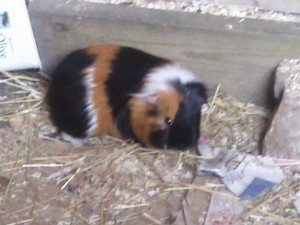 Toirteshell and White
Toirteshell and White
Tortoishell and white guinea pigs have patches of white, black and red that are even in size. If you are showing the guinea pig, it is best to have patches that have strong lines between each colour. I believe that patches of colour are favoured over stripes.
Tri-Colour
These guinea pigs, also called ‘dollie mixtures’ and ‘multi-colours’ have a colour from each of the black, white and red series.
If you have any questions about Cavy Colours leave a comment and tick the box at the bottom of the comment form if you want the reply emailed to you. One of our admin team will try to answer your question as soon as possible.
 August 25, 2010
·
August 25, 2010
·  Maddia (Admin) ·
Maddia (Admin) ·  13 Comments
13 Comments
 Tags: guinea pig breeds, guinea pig colors, guinea pig colours · Posted in: Guinea Pig Colours & Patterns, Guinea Pig Information
Tags: guinea pig breeds, guinea pig colors, guinea pig colours · Posted in: Guinea Pig Colours & Patterns, Guinea Pig Information


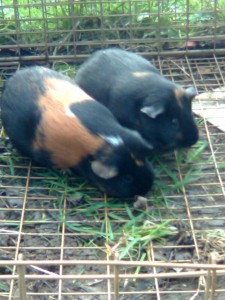
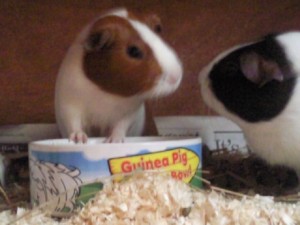
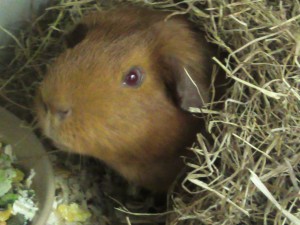
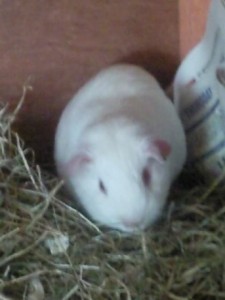

13 Responses
Hi
i was just wondering if you could describe what a tri colour guinea looks like as it would be alot of help for my work that i am doing, would it be possible to add about their body shape too thankyou x
Hi Natasha,
A Tri-coloured guinea pig is a guinea pig that has three colours on its body. One of the colours will be white, one from the red series fo colours and the third will be from the black series.
Because ‘tri-coloured’ is a term used to describe the colour of a guinea pig, tri-colours can be of almost any guinea pig breed.
The most common tri-coloured guinea pigs are are of the breed ‘short haired american or english’. These have short, sleek, smooth hair that’s about half an inch long. A lot of them have rounder faces with ‘roman’ noses. They are average sized guinea pigs, although you can sometimes get very bog or very small ones.
Hopefully this has helped :) Feel free to ask any other questions.
it will be helpful if you stuck more info on the dalmantion guinea pig
Hi Tammy,
Thank you for your suggestion.
We already have some information on this guinea pig under the heading ‘Dalmatian’. There’s also more info in the section about roan guinea pigs.
Shortly, I will be making a post about Dalmatian guinea pigs, so I’ll post a link in a further reply to this comment.
In brief, Dalmatian guinea pigs have a white body with a darker coloured spots and feet. They also have large ‘circles’ of colour on each side of their face similar to that of a Dutch guinea pig. Please note that you should never breed a Dalmatian with another Dalmatian or a roan (or a roan and a roan) as a lethal gene is likely to occur.
Check back later ready for the publication of your suggested post (I’ll post a link here).
I don’t always agree with your posts, but this was dead on, way to go!
Thanks for the information. We just got my son a dog and he absolutely loves that thing. I’ll admit, I was hesitant at first, but that little golden retriever puppy is pretty darn cute. Now my son wants a guinea pig too so I’ve been looking at colors. We just bought the dog a couple of soft dog crates though, so we’re probably going to have to wait a little while on the guinea pig.
I would just like to point out that guinea-pigs should not be put out to graze in a wire cage as shown in the top picture on this page. They can trap and break or seriously damage their legs, toes or claws which can cause extreme pain and be very difficult to heal.
It is far better to provide them with an enclosure where they can run, jump and stretch their legs in an unimpeded way. I might also point out that there is also a risk of damaging teeth in such a cage because due to their inquisitive nature they will try to pull out strands of grass that are trapped below the wires.
If you are concerned about predators you should either constantly supervise your guineas or create an enclosure where the cage is partially buried to allow grass to grow but ensure that predators cannot dig to gain access to the cage.
Hi, thanks for pointing this out, you’re absolutely right!
This was only a temporary measure and only that corner had the wire like that; we had to put it in that corner as the chicken wire was too big and they would’ve escaped, but it wasn’t ideal. Now we have a shed that they run around in, and an outdoor run where the wire’s buried.
Thanks again for making this point!
I just got my second guinea a three week old abbysian I seen the mother and father the father a crested top silk American Tri color and mother a Tri color Abbie the sisters all Tri colored Abby’s and my little Guy the only one I have seen even on internet he is black with a dark brown nose and a dark brown horizontal thin stripe across his back very small and he is abbisian what is his color called I don’t see anything like him..thank yoh
Im going to get a guinea pig today and have the hutch all ready and everything but im really confused about the run if i shouldn’t buy a wire run please tell me which types are safe
Thx xxx
Hi, your guinea pig will definitely need a run so it is important that you buy one. In general, most of the runs offered by pet shops are safe, but avoid any that have a wire floor (wire walls are fine).
The run that my guinea pigs has is one of the wooden triangular ones, which has no floor as it is just placed on the grass and the guinea pigs go straight on the ground. In appearance, it looks a little like a hutch, as it has a wooden (solid) door and a bigger compartment where the walls made of wire.
You shouldn’t buy a run that has a wire floor as pigs can get their feet stuck in the wire, and then break their toes, feet and/or legs which can be fatal.
Ideally, you want a run that allows guinea pigs to be outside, and able to eat the grass, but it must provide safety at the same time.
You can get some runs that have plastic walls, and an open top and bottom. These are good, however, because most fold up, they can sometimes fall down easily, and of course any open topped runs aren’t that safe from predators.
Whichever type of run you get, you must make sure it has a covered area that provides shelter from the sun as guinea pigs can get sunstroke. Any paint or varnish used should be safe for guinea pigs and there should be no sharp parts that could hurt your guinea pig. The run you buy should also be well made.
I’ve developing a breed that I call Abyruvian for 4 years now. The original boar was a Peruvian and the sow was Tortoiseshell and white Aby, hence Abyruvian. Most of my animals have 4 separate, definitive colors in their coat. You can see some of them on the facebook page. What color variety would you call that? This variety most nearly resembles the Abyssinian, although in most cases with only 4 rosettes. I have long-haired pups born at a rate of about 1 in 75. There hair typically grows out to between 1.5 – 3 inches long. I am now starting work on getting a longer haired variety established (I have several sows now, as well a 3rd generation longer-haired boar).
Thank you!
Warren
“I’ve been developing”